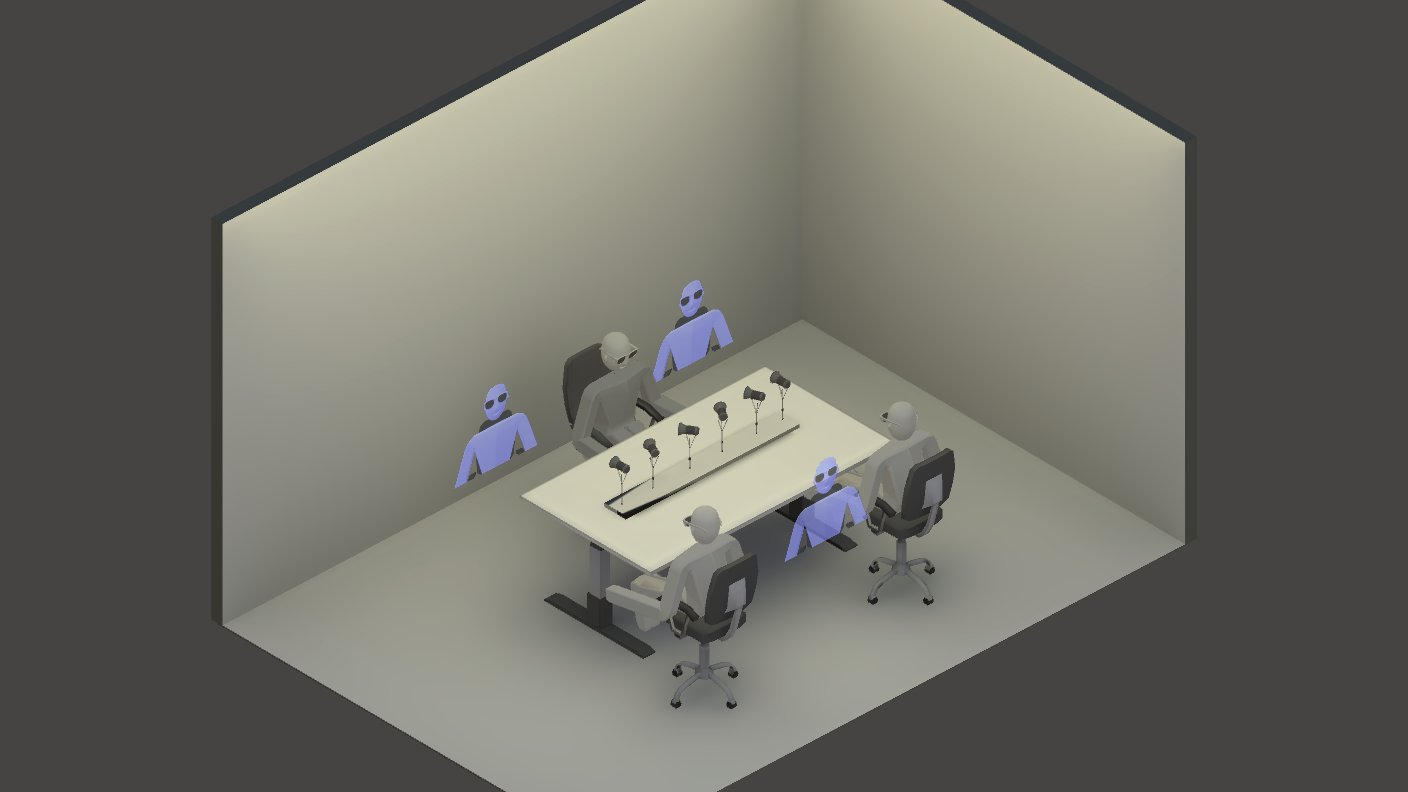
Amazon Special Projects
In January 2022, I was hired by Amazon to join their special projects division to help them develop a custom AR headset. As working from home had become more common during the pandemic, the idea was to design something that would allow remote teams (either fully remote or hybrid remote/in-person) to meet and collaborate as if they were together in-person. When I joined the team, they had just recently made the decision to pursue developing an AR solution (as opposed to VR) and had hired contractors to develop a proof-of-concept solution using existing AR hardware (in this case the Microsoft Hololens).
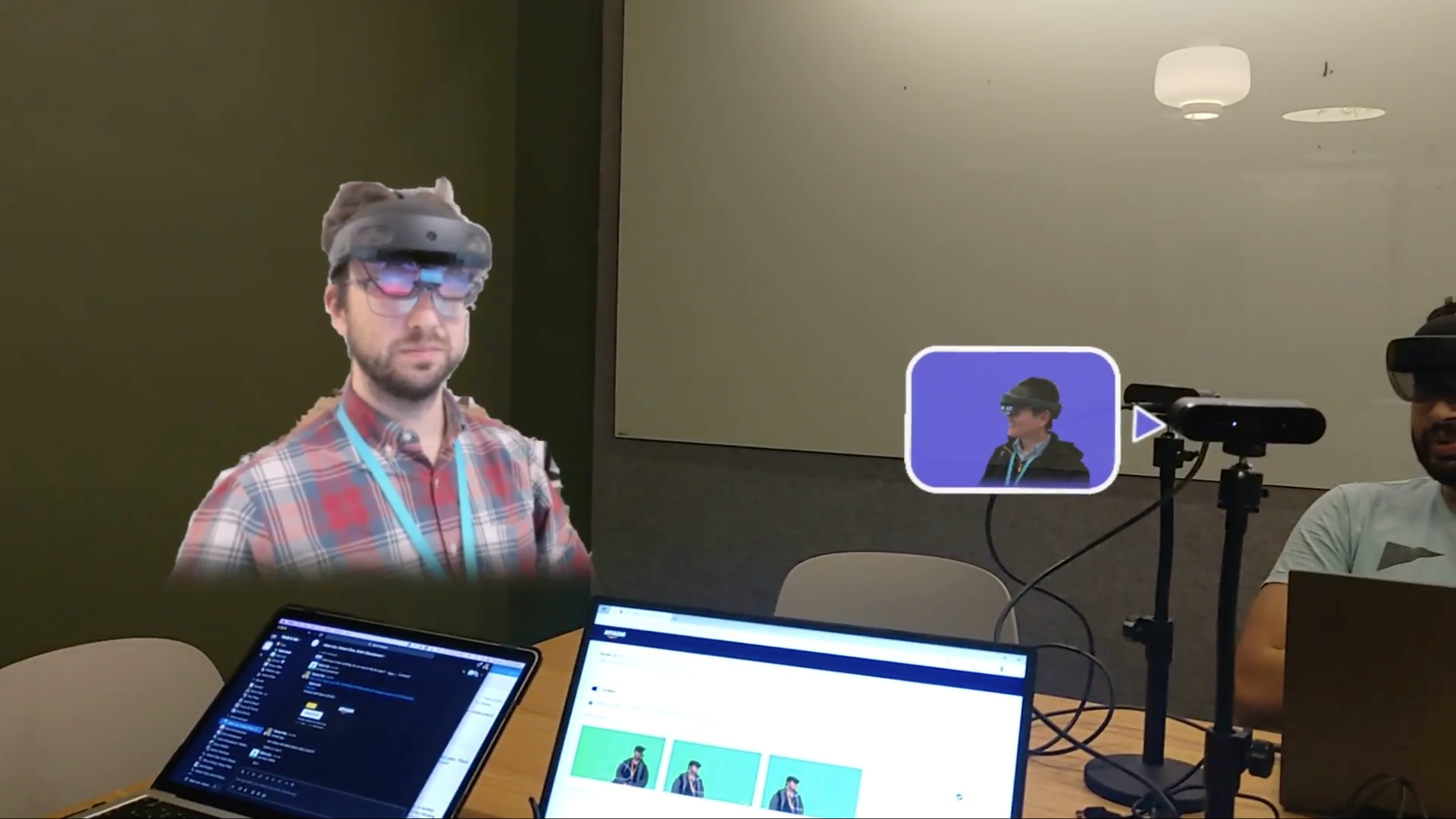
I started from a high level, looking at how people might use this product to help the hardware team answer questions about form factor and device specs. One challenge was thinking through how the hardware could work for both remote users working from home, as well as people in the office who may be in a room "co-located" with other users. This was my first exposure to Amazon's culture of documentation, and I put together a "2-pager" presentation outlining how various hardware choices would affect the end user experience. I discussed my recommendations, and worked with the hardware team to select components that would lead to an optimal user experience. I did similar research and presentations for other topics like head tracking (inside-out vs. outside-in) and input modality (tablet vs. controller vs. hand tracking).
For other key decisions, I worked in Unity to prototype features to help our team visualize how different choices would impact the final experience. For example, for the Hololens proof-of-concept we included the option to show a static 2D background behind remote users to make it feel more like a shared environment. However I felt a a 3D environment with dynamic lighting and shadows would feel more immersive, and rapidly prototyped a non-interactive version of the experience so others on the team could see what it would feel like. Another major question was around how the limited field of view of AR glassed would impact meetings with multiple participants. There were also questions around where we would place remote users in a physical environment, especially one shared by multiple co-located users. To address these issues, I simulated the various field of view options our hardware team was considering using a VR headset, then placed virtual content in a physical environment so we could better visualize the final experience of an end-user using our headset.
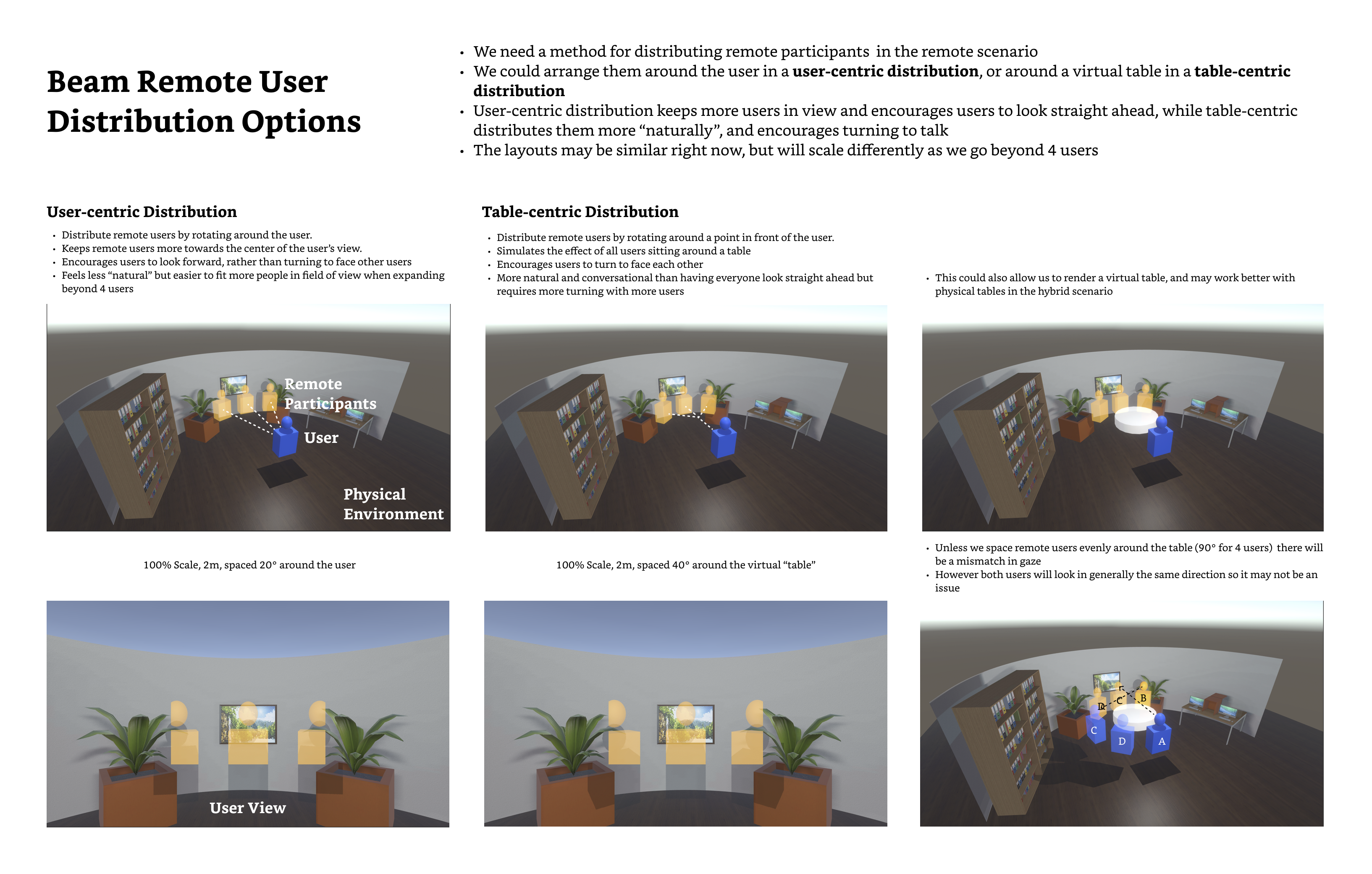
Another major challenge was to discover what factors would contribute to a sense of remote presence that would let teams feel like they were meeting in person, and how we could achieve that sense of presence using hardware that was comfortable, affordable, and easy to use. Our project was an offshoot of previous work to create a remote collaboration solution using high resolution screens and we inherited their research on drivers of presence. However this was based on a 2D screen which lacks many of the spatial cues of augmented reality and was also designed around 1-on-1 conversations, while one of our requirements was to support meetings of up to 8 participants. So to supplement this, I conducted additional research on drivers of social presence in AR/VR and ran internal tests to validate the level of precison required for a sense of eye contact. I presented these findings to the team, and identified what features would be required to create a satisfying sense of presence.
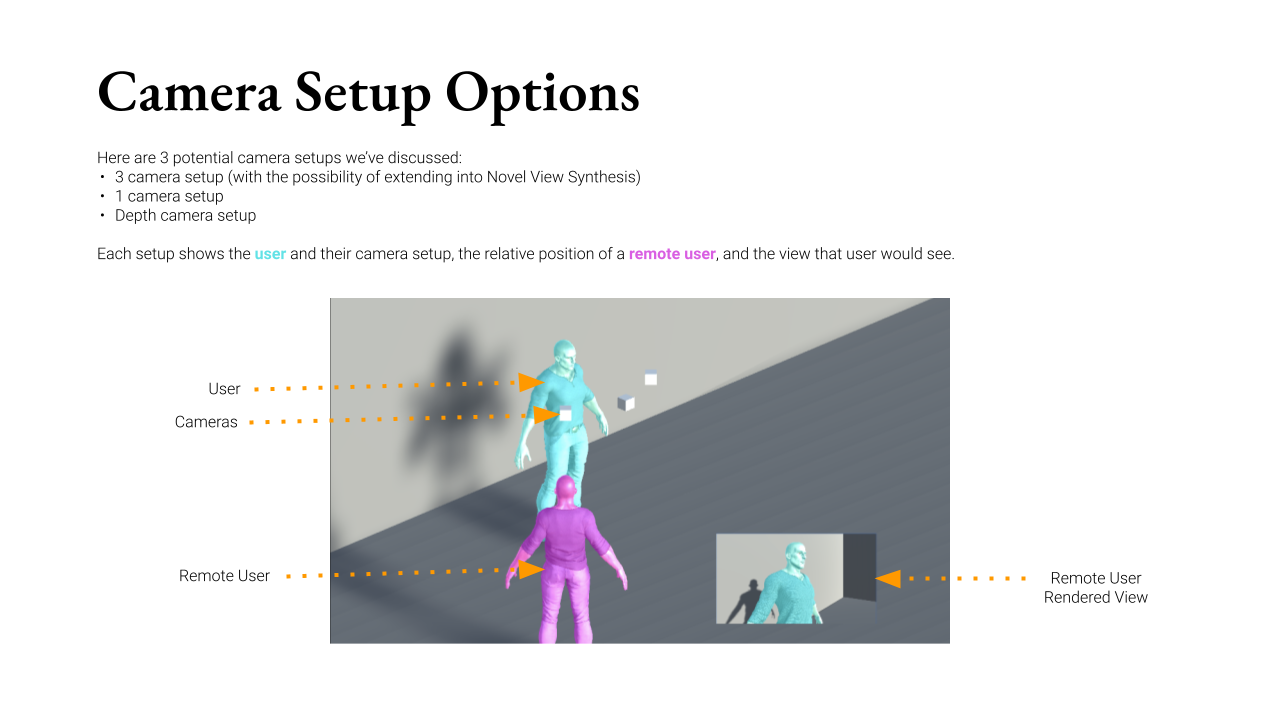
While I was originally hired as a UX Designer, in my second week our UX Researcher quit and I took over her responsibilities as well. I ran two major user studies designed to measure the performance of our solution, and benchmark it against traditional videoconferencing solutions. I researched questions and worked with UX researchers elsewhere in the company to write a survey questionnaire. I created test activities and recruited participants to use our product and compare it to a traditional video call. I compiled and analyzed the data, and used it to create recommendations to guide our development. This data was also shared with the executive team to build a case for future funding. This testing helped us identify several shortcomings of our initial approach, and after our first round of testing we shifted our approach to better create a lovable experience that was significantly better than existing videoconferencing solutions.
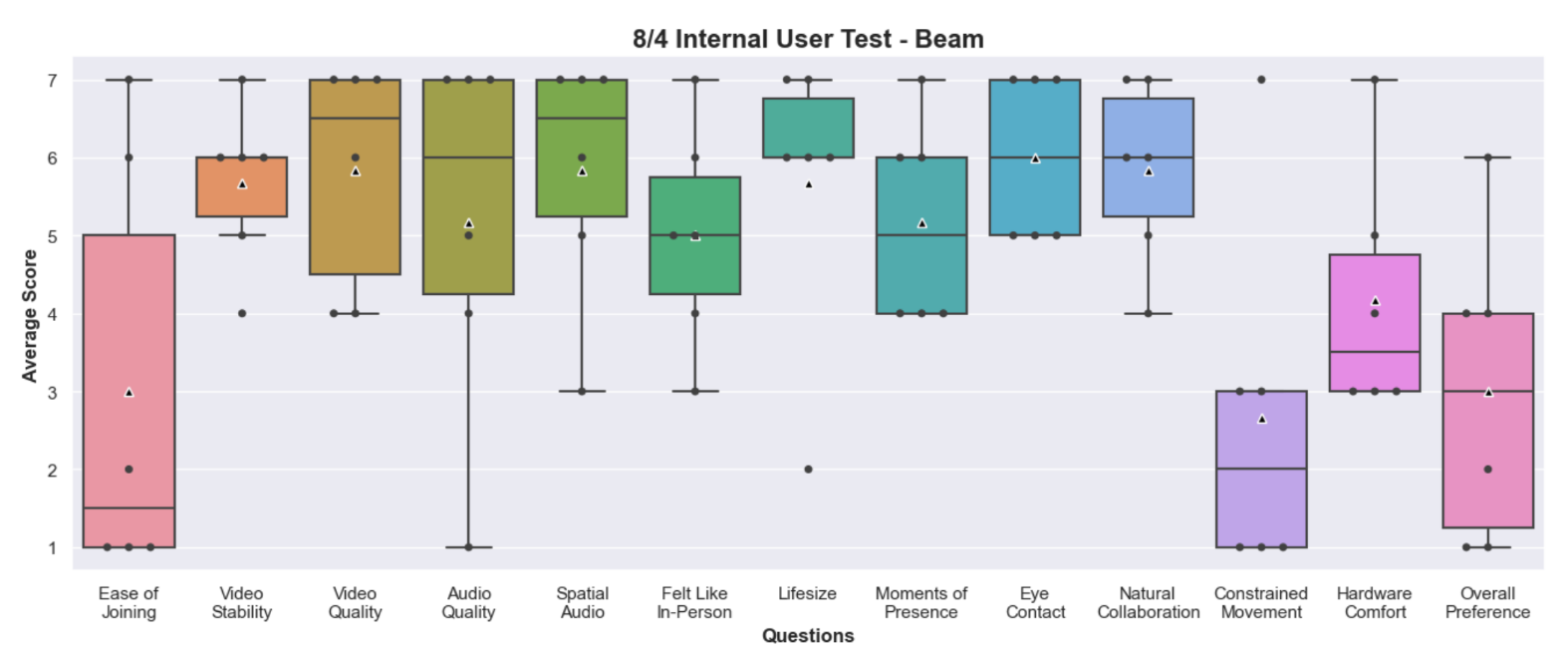
While the project was eventually canceled, I am proud of the work our team did. We were working in a fairly unexplored space, and took major steps towards creating a completely new-to-world experience. As a UX designer, this was my first opportunity to guide hardware development, and I greatly enjoyed the collaborative nature of working with hardware and optics engineers to build a product that had good design principles incorporated from the very beginning. I also had the opportunity to grow and explore UX research which taught me valuable data gathering and analysis skills.

I started from a high level, looking at how people might use this product to help the hardware team answer questions about form factor and device specs. One challenge was thinking through how the hardware could work for both remote users working from home, as well as people in the office who may be in a room "co-located" with other users. This was my first exposure to Amazon's culture of documentation, and I put together a "2-pager" presentation outlining how various hardware choices would affect the end user experience. I discussed my recommendations, and worked with the hardware team to select components that would lead to an optimal user experience. I did similar research and presentations for other topics like head tracking (inside-out vs. outside-in) and input modality (tablet vs. controller vs. hand tracking).
For other key decisions, I worked in Unity to prototype features to help our team visualize how different choices would impact the final experience. For example, for the Hololens proof-of-concept we included the option to show a static 2D background behind remote users to make it feel more like a shared environment. However I felt a a 3D environment with dynamic lighting and shadows would feel more immersive, and rapidly prototyped a non-interactive version of the experience so others on the team could see what it would feel like. Another major question was around how the limited field of view of AR glassed would impact meetings with multiple participants. There were also questions around where we would place remote users in a physical environment, especially one shared by multiple co-located users. To address these issues, I simulated the various field of view options our hardware team was considering using a VR headset, then placed virtual content in a physical environment so we could better visualize the final experience of an end-user using our headset.

Another major challenge was to discover what factors would contribute to a sense of remote presence that would let teams feel like they were meeting in person, and how we could achieve that sense of presence using hardware that was comfortable, affordable, and easy to use. Our project was an offshoot of previous work to create a remote collaboration solution using high resolution screens and we inherited their research on drivers of presence. However this was based on a 2D screen which lacks many of the spatial cues of augmented reality and was also designed around 1-on-1 conversations, while one of our requirements was to support meetings of up to 8 participants. So to supplement this, I conducted additional research on drivers of social presence in AR/VR and ran internal tests to validate the level of precison required for a sense of eye contact. I presented these findings to the team, and identified what features would be required to create a satisfying sense of presence.

While I was originally hired as a UX Designer, in my second week our UX Researcher quit and I took over her responsibilities as well. I ran two major user studies designed to measure the performance of our solution, and benchmark it against traditional videoconferencing solutions. I researched questions and worked with UX researchers elsewhere in the company to write a survey questionnaire. I created test activities and recruited participants to use our product and compare it to a traditional video call. I compiled and analyzed the data, and used it to create recommendations to guide our development. This data was also shared with the executive team to build a case for future funding. This testing helped us identify several shortcomings of our initial approach, and after our first round of testing we shifted our approach to better create a lovable experience that was significantly better than existing videoconferencing solutions.

While the project was eventually canceled, I am proud of the work our team did. We were working in a fairly unexplored space, and took major steps towards creating a completely new-to-world experience. As a UX designer, this was my first opportunity to guide hardware development, and I greatly enjoyed the collaborative nature of working with hardware and optics engineers to build a product that had good design principles incorporated from the very beginning. I also had the opportunity to grow and explore UX research which taught me valuable data gathering and analysis skills.